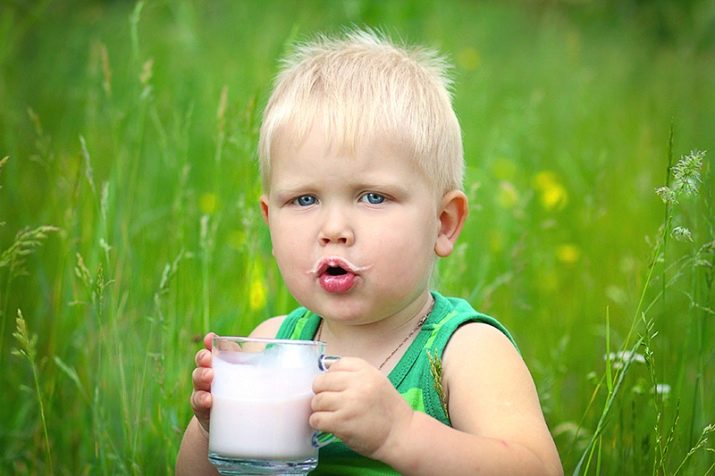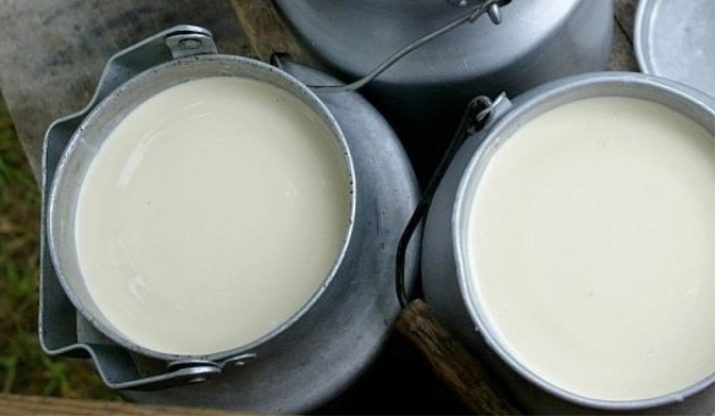Fresh milk: what is, benefits, harm and especially drinking

Fresh milk is considered to be the most useful. It is readily given to children, adults drink.It is considered the most natural and makes it clear the taste of real milk in its, so to speak, original form.
Product Description
In the literal sense of the word, milk is called a pair, which they have just drunk and have not yet cooled. However, depending on the storage conditions, it may also imply milk, which has not been subjected to heat treatment and has retained its bactericidal properties. No wonder in ancient times, fresh milk was considered a medicine.
The fact is that due to the high content of immunoglobulins, leukocytes and enzymes, it can suppress microbes. Thus, their number during the first two hours is not only not growing, but also decreasing. After this time, under the influence of the external environment, useful elements are destroyed.
To prolong the bactericidal effect, milk should be cooled in a refrigerator or cold water. Reduce the temperature should be gradually.
Definition of truth
Without special laboratory equipment to determine the quality of milk in several ways.
- Visually if the milk was not diluted with water or mixed with another, it should look homogeneous, without lumps. Depending on the fat content, it should be quite thick and dense. If a drop falls to the surface and spreads into an ugly blot, it’s most likely that the composition of the water is above the norm. Ideally, the drop should be small, dense, with smooth edges.
- Sour smell indicates that microorganisms began to multiply in milk in large quantities, and milk began to deteriorate. Other unpleasant smells can occur if dirt has gotten in there, or an animal has a health problem. Goats and other animals have their own specific smell. It should not be sharp. In fact, even milk from a cow smells, it's just more familiar to us.
- Colour depends on many different factors. Different meadow herbs and feed can give a slight yellow or cream shade. The pinkish or bluish tint should alert you - in this case, the milk may be with blood or water.
Fatness
One of the important indicators of which breeders are proud is the fat content in milk. In the paired state, it is in the form of small droplets, evenly distributed in the total mass. After a few hours, it forms a thicker upper layer, which is called cream. Per 100 grams of product, the proportion of fat averages 4.5% Argued that the taste of milk depends on its fat content. The higher it is, the tastier it is. In addition, it varies during the day, but can not be below 2.8%.
Calorie content
The energy value of products is measured in kilocalories (kcal). It adds up from the calculation of the content in the product:
- proteins;
- fat;
- carbohydrates.
The content of proteins and carbohydrates in milk of different fat content is almost unchanged. Therefore, calorie content depends on the fat content. For 3.2% - about 60 kcal, for 4.5% - 74 kcal per 100 grams.
What is useful?
Every person hears about the benefits of milk from childhood, especially if it is fresh. But few understand why.
- First, it enhances not only local, but also general immunity. Of course, if you use it regularly.
- Secondly, it contains large amounts of vitamins and trace elements (they can be counted about fifty). Moreover, nature has created a unique balance in which they are absorbed more carefully. Fresh milk can be drunk to prevent diseases of the bones, teeth and muscles.
- Thirdly, lactic bacteria contribute to the formation of the correct microflora in the intestine.
- Fourth, the cholesterol contained in it does not in any way harm the human body, but, on the contrary, participates in the construction of cells and tissues (in particular, the brain).
- Fifth, it has a beneficial effect on hormones and reproductive function.
- Sixth, milk is included in the list of dietary products for diseases of the liver, pancreas, intestines.It speeds up the metabolism and helps to burn excess fat.
Finally, it has an excellent balanced sweet and salty taste. A glass of fresh warm milk relaxes the nervous system, providing a good sleep.
Harm
Despite all the beneficial properties, there are many arguments that milk is harmful. One of them is a theory that assumes that cow and goat's milk is well suited only for its appearance. To break down the proteins, fats and carbohydrates that make up it, enzymes and hormones are necessary that can cause a number of diseases. In confirmation of this, data on an increase in cases of lactose deficiency are given. Moreover, it is proved that with age, the production of relevant enzymes decreases. Therefore, it is better for adults to eat sour-milk or low-lactose milk products.
Eating cow's milk in early childhood can lead to allergies. In this case, you can try the same product, but from another animal species (for example, goats). Since the protein composition will be significantly different. In the same cow most often allergy causes this type of protein, like casein.
Buy fresh milk in the store is not possible. It is usually shipped directly. Therefore, in matters of milk quality, you can only rely on the conscience of the owners. Very often, in order not to lose profits, buyers are not informed about diseases. Therefore, the composition may appear antibiotics. And the ingress of blood due to wounds and mastitis will not be pleasant.
As a result of poor-quality feed, heavy metals can enter the body of animals. Most often, people suffer from uncleanliness of their owners. The dishes remain dirty or with traces of detergents, and the storage rules are not always respected. Such cases are rare, but they also occur, since it is very difficult for private households to establish any kind of control.
Terms of Use
To make fresh milk only good, It is important to follow the rules of its use.
- Before you buy milk, make sure that both the animal and the milkmaid are healthy. This can confirm the relevant medical records. The animal should undergo a regular examination at the veterinarian, as some diseases in the early stages are asymptomatic.
- Make sure that in the process of milking all the necessary sanitary and hygienic rules are observed. Of course, directly to the place of detention of cattle you may not be allowed. But you can watch the way the milk is fed and bottled.
- Before use, milk is better to filter yourself again through the folded in several layers of gauze or strainer. If you doubt the purity of the container or the state of health of the supplier - refuse to use. Or in extreme cases boil it.
- Taste and color can vary depending on the animal's health, food, conditions and even the season.
- In the summer, it is better to take milk from the morning milking, because it has the most balanced composition. In addition, due to the increase in time intervals and heat in the evening it can burn out and have an unpleasant taste.
How to store?
In order for milk to retain its freshness, taste and healthy qualities as long as possible, it is important to properly store it. For this it is important to follow a few basic rules of storage.
- Fresh milk cannot be poured into plastic bottles. Despite their convenience, they are the worst dishes for him. First, poor quality plastic can release toxins. Secondly, it is difficult to wash the bottles well even with brushes. Remaining inside the bacteria, when released into such a favorable environment, will multiply very quickly and may harm the human body.
- The best container is a glass jar with a tight-fitting lid. If possible, they must be sterilized. Even for this purpose, suitable special cans, jugs of clay, milk jugs from porcelain or earthenware. They significantly increase the shelf life.
- No wonder this product is called a pair. Immediately after milking, steam over the milk can be seen with the naked eye, especially if the room is cool. That is why it can not be put in the fridge immediately.
- Actually, fresh milk is considered the first two hours after milking. If you do not have time to use it during this time, the container should be placed in the refrigerator.
- Tara must be tightly closed. Since constant contact with oxygen accelerates oxidative processes. In addition, all the dairy products in the open instantly absorb foreign odors. Take care not to lay open meat products, fish, eggs next to it. Not only raw, but also boiled products can serve as an additional source of pathogenic microorganisms.
- The shelf life depends on the initial purity of the product. At room temperature, store no more than 6 hours. At temperatures from 0 to 4 degrees to 8 days. The higher the temperature in the refrigerator or room, the sooner it will deteriorate. Exposure to direct sunlight, which can destroy vitamins, should be avoided. Low temperatures act destructively, because after defrosting, not only the appearance and texture will change, but also the composition - the protein will be destroyed.
- Extend the shelf life without a refrigerator by boiling. Moreover, it is necessary to boil at least twice a day.
Whether fresh milk is beneficial, see below.






























